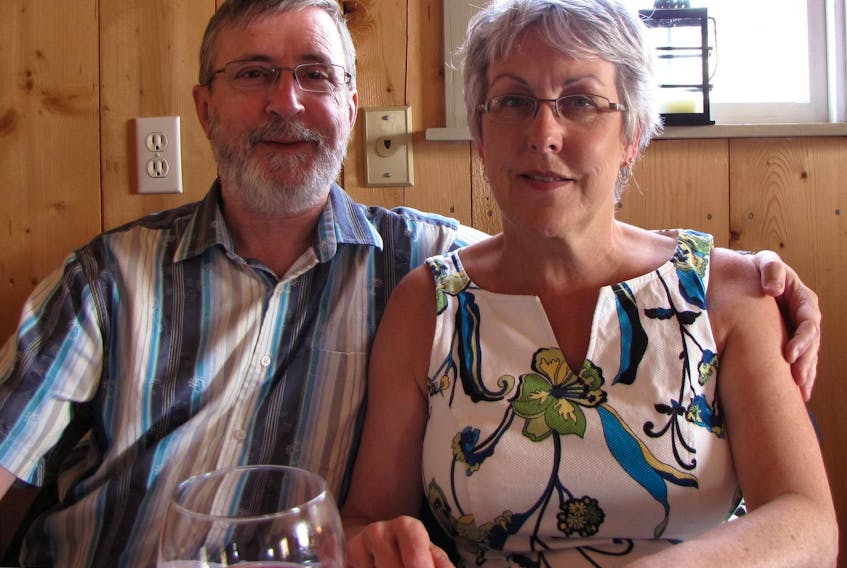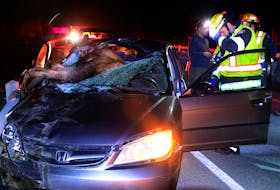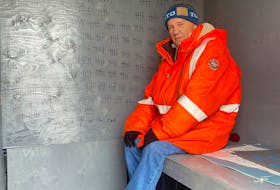ST. JOHN'S, N.L. — Stan and Linda Laite take their temperatures twice a day, and report the readings to the public health nurse who calls in the morning and evening.
On April 20, if symptom-free, the St. John’s couple will be out of self-isolation and finally able to go for a good long walk outside, more than a month after things turned surreal on a cruise ship vacation that made international headlines.
At the beginning of March, the Laites left for Buenos Aires for a 31-day South American cruise beginning March 7 aboard Holland America's 1,200-passenger Zaandam. At the time they left St John’s there were no travel alerts.
But when COVID-19 became a global pandemic and dozens of passengers and crew aboard the ship began exhibiting flu-like symptoms — almost 200 at one point — the Zaandam was turned away from ports, preventing those aboard from getting home once the shipping line suspended its cruises.
Eventually, four people died, two confirmed as a result of COVID-19.
The ship had not docked since March 14, although it took on supplies, and the Laites and others onboard spent a nervous few days wondering if it would be allowed to pass through the Panama Canal, which it did on March 30.
By that time, the Rotterdam was sent to travel in tandem with the Zandaam. The previous weekend, hundreds of passengers were transferred to the Rotterdam, to give people in inside cabins a chance to have a window.
The Laites remained on the Zaandam, where they had a window, but no balcony.
The sight of the Rotterdam was a brightener in tense times.
“We knew we weren’t alone in it anyway,” Stan recalled in a telephone interview from their St. John's home Wednesday..
“(That) Thursday night, Linda said, ‘Oh my God, come and look. This is the Rotterdam all lit up.’”
But there was one view out their cabin window that still shakes the couple.
When they finally got to dock in Port Everglades, Fla., at the beginning of April — after state and Broward County officials debated whether or not to allow the cruise ships in — the Laites’ window was only about 10 feet away from where sickened cruise ship passengers were being offloaded on stretchers.
“When we saw a couple (of them) all hooked up to machines. We lost it,” Stan recalled, describing the scene of people covered in sheets as they were transported to a medical facility arranged to care for them by Holland America.
“That was the most difficult. It just about broke my heart,” said Linda, whose voice quivered Wednesday as she spoke about it.
The Laites and other passengers sequestered in their cabins learned during the captain’s address from the bridge that they would indeed be allowed to dock, and the evening of April 2, they had to proceed down the gangway six feet apart to U.S. customs, where they held their passports up for inspection — from a distance. They had their temperatures taken and they filled out a questionnaire. The passengers all seemed to be in a semi-trance.
Earlier that day, their suitcases had been taken away for sanitizing.
“The whole place was covered in Tyvek (style plastic). Everything was covered and sealed." - Stan Laite, of Toronto hotel
“It was so strange when we went in there, people we had seen on the ship — we wanted to talk, but we had to keep our distance,” Stan recalled.
Before the COVID-19 pandemic was declared, upending the routine aboard the cruise ship, the Laites kept encountering another couple seemingly everywhere they went, always exchanging greetings.
They saw the woman from afar at U.S. customs, and wondering why she was on her own was tough.
“We couldn’t speak to her — we had to obey the rules,” Stan said. “We don’t know whether he passed (away) or he was kept on the ship.”
(Passengers who showed any symptoms, but were not in need of immediate medical attention, were kept aboard until they were well enough to travel.)
The next day, when the Laites and the others who were deemed fit to travel disembarked, the police, sheriff's officers and everyone else they dealt with were dressed in crime-scene-style white protective garb, and the passengers, as they did throughout the entire journey home, wore masks and gloves.
But Stan said everyone was kind to them. The passengers had been apprehensive, as the headlines and news reports showed Florida officials, including the governor, initially not wanting to take the ships due to the fear of COVID-19 and overwhelming the state’s hospitals.
(Holland America was required to submit a plan, including details about how the sick would be handled.)
“They were nothing but positive,” Stan said of the reception and smooth procedure when passengers disembarked. “They said, ‘Don’t worry, this will soon be over. You’ll be home with your loved ones tomorrow.’”
They were even given a little goody bag with chips and odds and ends.
They boarded buses that headed straight for the tarmac and their charter flight to Toronto.
Onboard the bus, spirits were lifted, Stan said.

There was a 24-police motorcycle escort and every access road was closed as they proceeded.
“One of the ladies across from us said she had to practice waving like the Queen,” he said of the experience.
“It’s the first time in my life I have ever had a motorcade.”
The plane was a type that Stan said he hadn’t seen in years, and there were 250 Canadian cruise ship passengers aboard, but everyone had their masks and gloves, and the crew were completely covered in white protective outfits.
Since he has been home catching up on media coverage of the COVID-19 pandemic, he has realized the variations in symptoms and the potential risk of having been on the crowded plane.
But three hours later they were in Toronto, where a quarantine officer gave them instructionsover a speaker about what was to happen.
“Toronto was absolutely amazing, how well it was organized,” Stan said.
Everyone they encountered had masks and yellow gowns, like something a nurse would wear in the OR, Stan said.
Still, there was a lot of empathy among airport and security officials and airline and other staff for the passengers — a woman apologized to Stan that they were going to have to wait.
“I said, ‘My dear, waiting five or 10 minutes is nothing in the scheme of things, don’t you worry,’” Stan recalled.
When one passenger stumbled on an escalator, six or eight workers rushed to his aid.
They were handed colour-coded tags for their status — whether they were leaving the airport for their cars, or going on to other flights.
Stan’s was orange.
The Laites went to the Radisson Hotel to wait for their flight the next day.
“The whole place was covered in Tyvek (style plastic). Everything was covered and sealed."
They met the Red Cross and filled out another health questionnaire and their luggage was brought to their suite, from which they were not allowed to leave. All their meals were left outside the room. They were put aboard a mini-bus the next day to go to the airport, and were separated from the driver.
The bumper-to-bumper traffic that would normally be found on the run to the airport was non-existent.
No airline staff were gowned on the Westjet flight home to St. John’s, but there were only 18 to 24 people aboard, Stan said.
They had no onboard service or contact with the crew, but the Red Cross had given them water beforehand.
Finally, on Saturday afternoon, April 4, they arrived at St. John’s International Airport, where their landlords, who are longtime friends, dropped off their car and waved to them.
Back at their apartment, there were prepared meals waiting, and friends and family have been delivering groceries and meals since.
Linda said she has been doing crossword and word search puzzles, having Skype sessions with family and following a TV exercise program.
“It’s such a relief,” she said of reaching home.
Onboard the cruise ship, they had access to free internet and phone calls, so they were able to stay in touch with family, including her worried mom, who is in a long-term care facility.
Stan can't say enough about the ship’s captain, who kept the passengers informed three or four times a day through his announcements, but never before verifying his information.
"Everybody on the ship had confidence in him,” Stan said.
The most stressful time for Stan was the two or three days when they didn’t know if they would be allowed through the Panama Canal, but once that was announced they felt someone would take them.
The captain told the passengers who had balconies to stay inside.
Most people turned their lights off so they could see the canal progress out their windows.
Stan said they already have a deposit on a cruise next year, should everything be fine by then.
“We’ll monitor it closely,” he said.
They also hope the COVID-19 crisis will be over so their daughters can come home for a visit this summer.
But long before then, despite the restrictions everyone is living under during the public health emergency, the Laites have something to look forward to when their quarantine is over.
“We really miss that — Stan and I go for a walk every single day,” Linda said of when they can finally go off their property.
@BarbSweetTweets









